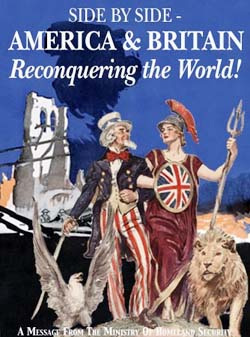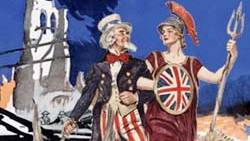Perfidious Albion: An Introduction to the Secret History of the British Empire
Source: newdawnmagazine.com
 Perfidious Albion – “Treacherous England,” “Faithless England,” or, if you prefer, “Dirty, Low-down, Sneaky England” – is commonly assumed to derive from the French La Perfide Albion. The epithet’s best known appearance is in the 1793 poem “L’ere de Francais” by the Marquis de Ximenez. The year is not without significance. In February 1793, the increasingly radical and beleaguered French Republic declared war on Britain, and Ximenez exhorted his revolutionary countrymen to carry the fight to the enemy’s shores. One wonders what he would have made of the theory, advance many years later, that the very Revolution he praised was the clandestine handiwork of Perfide Albion.
Perfidious Albion – “Treacherous England,” “Faithless England,” or, if you prefer, “Dirty, Low-down, Sneaky England” – is commonly assumed to derive from the French La Perfide Albion. The epithet’s best known appearance is in the 1793 poem “L’ere de Francais” by the Marquis de Ximenez. The year is not without significance. In February 1793, the increasingly radical and beleaguered French Republic declared war on Britain, and Ximenez exhorted his revolutionary countrymen to carry the fight to the enemy’s shores. One wonders what he would have made of the theory, advance many years later, that the very Revolution he praised was the clandestine handiwork of Perfide Albion.In any event, the good Marquis was hardly the first or the last to invoke the term. References to something of the kind date back to the late Middle Ages. In 1919, Canon Charles O’Neil enshrined it in the lyrics of “Foggy Dew,” which lauded Ireland’s Easter Rebellion. The Spanish, recalling the ill-fated Armada and the depredations of Sir Francis Drake, speak of Perfida Albion, the Italians of Perfida Albione, and the Germans of Perfides Albion. In any language, it boils down to the same thing: the English displayed a special knack for underhanded behaviour and more that they were damned good at it.
Is such sniping just the reflexive bitterness of losers, or was the rise and success of the British Empire really abetted by dirty tricks and not just hardy seamen, stiff upper lips and the will of the Almighty? If so, much of the dirty work falls into that category loosely termed espionage or “secret service.” But the English did not invent spying, which if not the world’s second oldest profession, must be the third. Nor can it be that Britain’s alleged sin was simply putting its interests above that of any other nation, be it friend or foe. What other country can really claim to have done otherwise, and why should anyone expect them to?
Of course, we are talking about more than mere intelligence gathering; suborning treason, inciting rebellion, even war, not to mention blackmail and assassination are neither the least nor the greatest crimes of which Perfidious Albion stands accused. Indeed, some might argue that the British Empire was born and maintained through a pact with the Devil himself. In any case, the likes of Stephen Dorril and Robin Ramsay argue that the long history of skulduggery manifests the hand of a British “Secret State” which continues to guide the policies and destiny of the United Kingdom.1
The notion than England possessed a special talent for deceit and underhandedness may be a myth, but it has proved an effective and enduring one. After all, though the Empire is gone, the most famous secret agent in the world, James Bond, remains a Briton. The long list of historical figures who stand accused of being Albion’s tools (whether they knew it or not) includes Christopher Marlowe, Benjamin Franklin, Karl Marx, Leon Trotsky and Adolf Hitler. Those who, to one degree or another, definitely were, include Aleister Crowley, Harry Houdini, Benito Mussolini and Noel Coward. What follows will take a necessarily very selective look at some of the persons and events involved in Britain’s clandestine affairs from the era of Elizabeth I to the Second World War. Some may be familiar, others definitely obscure, but each played a part in the Secret History of the British Empire.
Sir Francis Walsingham
Credit for creating the first “regular” English secret service usually goes to Elizabeth I’s spymaster, Sir Francis Walsingham.2 He faced a predicament shared by many of his successors; the need to combat both external and internal threats and the collaboration of the two. In the case of the Protestant Walsingham and his Protestant Queen, the unifying factor among their enemies was devotion to Catholicism. Walsingham battled this menace by recruiting agents at home and abroad and waging an aggressive campaign of counter-subversion. His most successful weapon was the provocateur or “mole” who penetrated and compromised hostile conspiracies. He also followed the maxim that England’s enemy’s enemy was her friend, or at least an exploitable tool. In addition to Protestant sympathisers and dissident Catholics, he is also supposed to have enlisted the help of witches, sorcerers and atheists in Albion’s cause.3
Little surprise that one of Walsingham’s better known operatives was an Elizabethan occultist whose interests included hermeticism, alchemy, astrology and conversing with “angels.” This was Dr. John Dee (1527–1608), a man whose encoded signature – a stylised representation of handled spectacles – was later appropriated by Ian Fleming for his “007.”4 Among other things, Dee was a prophet of England’s Manifest Destiny. He allegedly coined the term “Britannia” and conjured up the image of the small island kingdom as the centre of a world-girdling maritime empire.
While Dee served Walsingham well, he was first and foremost a scholar and seems to have lacked the ruthless quality often required of a secret agent. Thus, it surely was Walsingham’s hand that in 1582 steered Edward Kelley into his path. Dee wished to commune with the spirits but lacked mediumistic powers. Kelley had them – or claimed to – and the pair formed a team which endured for some seven years. Kelley was a dubious character, a convicted forger and counterfeiter whose occult interests included necromancy and maybe outright diabolism.5 Since the angels “spoke” through Kelley, and Dee was inclined to do whatever they decreed, Kelley was ideally positioned to “manage” Dee. Kelley would have had no qualms about doing whatever Walsingham required. Little wonder that some three centuries later another English occultist-spy, Aleister Crowley, would proclaim himself the reincarnation of Edward Kelley.
Dee and Kelley’s most important mission was their extended visit to Central Europe in the 1580s. This brought them to the court of Habsburg Emperor Rudolf II, nephew of England’s nemesis, Philip II of Spain, and host to a dangerous cabal of Catholic exiles. Kelley ultimately infiltrated and betrayed this group and their co-conspirators in England. Dee ingratiated himself (and by extension, Kelley) to Rudolf by providing the Emperor with rare tomes of esoterica. Dee is generally assumed to have sold Rudolf a very strange volume later dubbed the Voynich Manuscript after the book dealer who rediscovered it in the early 20th century.6 It is an illustrated manuscript depicting mysterious plants and rituals and written in an unknown and indecipherable alphabet. Among the multitude of theories about the book is one that holds Dee concocted it as cryptographic experiment based on the angelic or “Enochian” revelations received through Kelley.
Britain’s Alliance with the Jews
Half a century after Dee’s death, England was under a very different political regime but facing a remarkably similar security predicament. In the mid-1650s, power rested in the hands of a Puritan dictator, Lord Protector Oliver Cromwell. Cromwell’s principle enemies were the royalist partisans of the dethroned Stuarts who brewed sedition at home and plotted abroad with the Catholic kings of Spain and France.
At this time there lived in London a wealthy Portuguese-Spanish merchant named Antonio Fernandez de Carvajal. In fact, Carvajal was a Marrano or crypto-Jew, a descendent of Iberian Jews compelled to accept Catholicism in the previous century. Like many of his secret co-religionists, Carvajal hated Spain and all it stood for. He also sought to legitimise his and other crypto-Jews’ status in England and permit other Sons of Judah to live there openly. The obstacle was Edward I’s 1290 Edict of Expulsion which forbade Jews to dwell in England. In 1655, Carvajal arranged for Rabbi Menasseh ben Israel to come from Amsterdam and make a personal appeal to Cromwell. The Lord Protector formally repealed the Edict two years later. Part of the quid pro quo was that Carvajal put Cromwell’s agents in contact with a far-flung network of “Jewish Intelligencers” who operated in the Netherlands, the Levant, Spanish America and inside Spain itself.7 As early as 1656 this secret alliance proved its value when Carvajal’s agents exposed royalist intrigues in Holland.
Jump ahead 260 years and British agents in the Middle East, among them a certain T. E. Lawrence, were being aided by another network of Jewish spies, this one the Zionist NILI ring which worked against the Ottoman Turks.8 At the same time, Albion’s operatives spun visions of independence before the Arabs while quietly plotting to divide up the whole region with France. The leading light of the NILI ring, Aaron Aaronsohn perished in a mysterious plane crash over the English Channel in 1919. As in the later cases of the Duke of Kent (1942) and General Wladyslaw Sikorski (1943), suspicious minds saw the hidden hand of Perfidious Albion ridding itself of an “inconvenience.”9
At the very least, had Edward I’s Edict remained in force, British history would have been very different. No Rothschilds would have lent their weight to London’s financial might, no Benjamin Disraeli would have become prime minister, nor would a Polish Jew named Shlomo Rozenblium have become Sidney Reilly, the Ace-of-Spies.
The French Revolution has spawned its share of conspiracy theories. Perhaps the most resilient of these is the “Illuminati-Masonic Conspiracy” promoted by Abbe Augustin de Barruel in his Memoirs Illustrating the History of Jacobinism (1797–98) and John Robison’s Proofs of a Conspiracy against All Religions and Governments of Europe… (1797). Both writers point accusing fingers at the recently disbanded Bavarian Illuminati who, they allege, infiltrated French Freemasonry and spawned the head-chopping excesses of the Jacobins. It is worth noting that both Barruel and Robison wrote their books in Britain and that the government of Sir William Pitt the Younger embraced and promoted their ideas. At the very least, Pitt exploited the conspiracy theory to effectively discredit and demonise the French Revolution.
In the 20th century, the doggedly anti-British researchers associated with Lyndon Larouche’s Executive Intelligence Review argue that the hidden hand of England both helped to get the Revolution rolling and steered it into the hands of the fanatical Jacobins. In modern parlance, it was all a “destabilisation” effort designed to cripple France economically and politically. Even the storming of the Bastille was part of the plot.10 In the “Bestial British Intelligence of Shelburne and Bentham,” Jeffrey Steinberg singles out Lord Shelburne (William Petty) the evil genius of the venture who used the monetary power of the East India Company to carry out a silent coup against weak King George III.11 According to this view, British intelligence ever since has been the tool of the same secret power. If so, were the works of Barruel and Robison sponsored disinformation designed to divert attention away from the real conspiracy to a manufactured one?
Throughout the 19th and early 20th centuries, the British secret services had to negotiate a shifting landscape of alliances and real or potential enemies. In the 1850s, Britain joined traditional foe France in the Crimean War against Russia, but in the 1890’s France allied itself with Russia, a combination that was almost as troubling to Britain as it was to the rising power on the block, Germany. Up to the first years of the 20th century, Tsarist Russia remained the Empire’s #1 adversary, but when, after 1900, the Germans embarked on the creation of a big navy, British interests demanded an alliance with France (1904) and subsequently Russia (1907).
Of course, just because you were allied to someone, didn’t mean you would or should stop spying on them. To better manage intelligence operations, a War Office Intelligence Division appeared in 1873. The Admiralty followed suit with a Foreign Intelligence Committee in 1882 which became the Naval Intelligence Department (NID) a few years later.
William Melville
Nevertheless, the man who was the closest thing to a British spymaster in the late 19th century, and who arguably laid the basis for British intelligence in the 20th, came from the London Metropolitan Police – Scotland Yard. His name was William Melville and he was, of all things, a Catholic Irishman from County Kerry. Originally a baker, Melville entered the Metropolitan Police in 1872 and ten years later joined its new Irish Branch. The latter was designed to combat Fenian conspiracies, particularly bomb attacks in London. Despite his background, Melville became an implacable enemy of the Irish rebels and a bitter foe of anarchists and radicals generally.
In 1887, Melville was involved in ferreting out the so-called Jubilee Plot in which a Fenian cabal aimed to blow up Queen Victoria and most of her cabinet in Westminster Abbey.12 The key instigator turned out to be a British agent. Much the same emerged five years later when Melville masterminded the destruction of the Walsall Plot in which a group of anarchist workmen went to prison for scheming to build a bomb. Once again, the man at the centre of plot turned out to be one of Melville’s provocateurs.13
Befitting a servant of Perfidious Albion, such deviousness did not go unrewarded. In 1893 Melville became Superintendent of Special Branch and earned an almost mythical reputation as the ever-watchful guardian of public order. Always on the lookout for new angles in trickery and deception, in 1900 Melville enlisted the talents of American magician Harry Houdini. He even inveigled Houdini to spy for him during his tours of Germany and Russia.14
Still, this did not inhibit Melville from establishing cooperative arrangements with the secret services of those very same countries. In 1901, he worked with German agents to forestall an assassination attempt against Kaiser Wilhelm II at Queen Victoria’s funeral.15 He evolved a more elaborate relationship with Pyotr Rachkovsky, the equally cunning chief of the Russian Government’s Okhrana section in Paris. Melville’s men spied on Russian exiles in London, while Rachkovsky supplied Melville with intelligence gleaned from radical circles on the Continent. They even shared agents.
A case in point is the Pilenas brothers, Casimir and Peter. They were Lithuanian subjects of the Russian Empire who fled to London in the 1890s and moved in revolutionary circles. Casimir became a spotter and informant for Scotland Yard around 1896 and he and his brother worked as London operatives for the Okhrana.16 Their recruiter was one of Melville’s officers, Michael Thorpe who also, with Melville’s approval, worked for Rachkovsky.
The Okhrana came to doubt the Pilenas’ reliability and cut them loose in 1913. This may have had something to do with their peripheral involvement in a sensational robbery-murder in London in December 1910. The so-called Houndsditch Murders resulted from a botched burglary attempt by a group of Latvian-Russian anarchists.17 Three policemen were shot dead and not long after two of the suspects died in a fiery shoot-out in the East End’s Sidney Street. Despite what first appeared to be overwhelming evidence, the surviving robbers were all acquitted. One reason for the acquittals may have been that there was one or more police agents among the accused.
The group’s shadowy ringleader, “Peter the Painter,” was never found, but among those suspected was Peter Pilenas who conveniently left England for America just days before the robbery went down. Peter soon was followed to the States by brother Casimir. When the First World War broke out, British intelligence in New York re-mobilised him as an agent, and he similarly returned to Albion’s service (if he ever left) in 1939.
There is something fishy about the Houndsditch/Sidney Street business, and the suspicion that it involved State-inspired provocation is not unjustified. In that respect, a not insignificant detail is that the Home Secretary who personally oversaw the Sidney Street shoot-out was Winston Churchill, a man who some believe “had already sealed an indissoluble bond” with the Realm’s secret services.18
Melville resigned his Scotland Yard post in October 1903 but immediately opened a private detective agency under the name William Morgan. In fact, Melville’s outfit was a cut-out for the War Office and served the Empire’s secret needs at home and abroad. Basically, Melville’s agents did the Empire’s dirty work under a cover of complete deniability. In 1909, most of his organisation was subsumed into two new agencies created to handle domestic and foreign intelligence (what would become MI5 and MI6) and Melville served as MI5’s Chief Detective until his real retirement in 1917.
Sidney George Reilly
One of Melville’s most notable recruits was the Russo-Polish Jew mentioned earlier, Shlomo, or Salomon, Rozenblium. He would be much better known as Sidney George Reilly. His career is too convoluted to summarise here, but among other things, he is frequently cited as the role model for James Bond.19 Like so many things about Reilly, it turns out to have no basis in fact. In reality, Reilly was more a confidence man than a spy, and his loyalty to Britain, or anything else, was doubtful. A report on his character in early 1918 concluded that he was “a shrewd businessman of undoubted ability, but without patriotism or principles and therefore not to be recommended for any position which requires loyalty….”20 Other terms applied to him included “untrustworthy” and “unscrupulous.” Among the few things said in his favour was that he had excellent sources of information and “connections in almost every country.”21 Reilly liked to hint of his connections to the “Occult Octopus,” his name for the more secretive aspects of international business and finance.22
Nevertheless, despite his mercenary reputation, or maybe because of it, in the spring of 1918 the chief of London’s Secret Intelligence Service (SIS or MI6), chose Reilly to undertake an ultra-secret mission inside newly Bolshevised Russia. The main fruit of this venture was the so-called Lockhart or Ambassadors’ Plot which reached its crescendo in late August of that year. The plot centred on a plan, spearheaded by Reilly, to subvert the Latvian troops guarding the Kremlin and use them in a palace coup against Lenin’s government. The goal was less the total overthrow of the Red regime than a change in its leadership, and there is little doubt that an almost simultaneous, but botched, effort to kill Lenin was connected.23 The Latvian gambit abruptly fell apart with the result that all the Allied secret services in Russia were compromised. Reilly and his British colleagues escaped unscathed, but his American counterpart, the unlikely named Xenophon Kalamatiano, was not so lucky. He alone was tried, convicted and imprisoned by the Bolsheviks for three gruelling years. To his dying day Kalamatiano maintained that Reilly had deliberately betrayed him and other Allied agents.24 What he never seemed quite sure of was why.
Sidney Reilly disappeared on another mission to Russia in the fall of 1925. According to contradictory Soviet accounts, either he was executed soon after his capture or almost two years later. In London there were routine denials and whispers of defection. In what purports to be an account of his interrogation, Reilly emphatically states that there had been no British agents in Russia since 1919.25 It may be that one purpose of Reilly’s mission was to convince his Soviet captors that this was true. Persons in London may have willingly sacrificed Reilly to make that point.
It was vital that the Soviets believe him, because nothing could be further from the truth. As researcher Phil Tomaselli has unearthed, from the fall of 1919 through at least mid-1923, MI6 received scores of reports, many very detailed, from a source with access to the highest levels of the Soviet Government. The source was also particularly well-versed in the secret collaboration between the Russians and the German military. Codenamed D-57, the agent’s identity was carefully disguised; indeed, it is not clear whether D-57 was an individual or a network of informants. As far as can be determined, the information provided was reliable.
D-57 was only a part of a much more extensive British intelligence operation in Red Russia. As a 1927 American military intelligence summary put it, “Just what agencies are maintained [by the British] in Russia, of course, cannot be found out, but according to recent Soviet claims, which are undoubtedly exaggerated, the British have an extensive system of espionage in that country.”26 Actually, the Soviets were not hallucinating. London had intelligence officers imbedded in its trade and diplomatic missions, and in the ranks of private firms operating in Russia. Through the 1920s, a super-secret MI6 station existed in Moscow, though, like D-57, it remains completely unacknowledged in that agency’s official history.27 Why? Why would such a seemingly outstanding success be covered-up? Could it be that to reveal the story of D-57 and related affairs would also reveal some darker secrets of the Empire, those that must forever remain in the file of Things That Never Happened?
Dr. Cornelius Herz
The Soviets were not the only ones who had to fret about the nefarious activities of English spies. The French had ample reason to maintain a healthy paranoia about L’Intelligence Service. Around 1877, a certain Dr. Cornelius Herz appeared in Paris. Although supposedly born in France, Herz claimed American citizenship, but his origins are, to say the least, obscure. He used his not inconsiderable wealth, the source of which was also a mystery, to dabble in finance and politics, initially to great success. He cultivated political figures in the Third Republic, most notably the sabre-rattling General Georges Ernest Boulanger, who almost staged a coup against the Republican regime at the end of the 1880s. Herz also befriended a rising politico named Georges Clemenceau, the future “Tiger of France.”
However, Herz’s little empire came crashing down when, along with another wheeler-dealer, the Baron de Reinach, he became mixed-up in the Panama Canal Scandal that hit France at the beginning of the 1890s. The Scandal, which included charges of bribery and official malfeasance, rocked the Republic to its foundations. To avoid prosecution, Herz, like others implicated, fled aboard, but it was the place of refuge he chose that raised eyebrows. Herz decamped to England in 1892 where, despite vigorous French efforts to force his extradition, he remained safe and silent until his rather untimely (some might argue convenient) death six years later.28 In France it became an article of faith that Herz had been an “agent-of-influence” of Perfide Albion and that his aim all along was to destabilise the Third Republic any way he could. Some of his critics charged that Herz was nothing less than the “chief of the Intelligence Service in France.”29 Herz, naturally, denied any such thing.
It was not lost on certain persons, among the outspoken anti-semite Eduoard Drumont, that Herz and Reinach were Jews, and this played into another scandal that hit the Republic in 1894 and raged for several years – the infamous Dreyfus Affair. By 1898–99, it had polarised France into pro- and anti-Dreyfusard camps and again brought the Third Republic to the brink of collapse. Britain’s secret services were not above fishing in these troubled waters. One man who thought the Republic’s crisis might be his opportunity was Victor Bonaparte, Prince Napoleon, or as die-hard Bonapartists referred to him, Napoleon V. From his exile in Belgium, he boasted of organising a march on Paris to seize control and restore order. Among the surviving records of War Office Intelligence, there is reference to the fact that in May 1901, British agents met with Prince Napoleon in Holland where they “sounded out” his views about affairs in France and elsewhere.30 So, the Empire’s agents now connived with the heir of the man they had worked so hard to bring down almost ninety years before.
Basil Zaharoff
Some thought it more than coincidence that just as Herz’s star began to fade, another foreigner of mysterious wealth and provenance popped up in Paris.31 This was Basil Zaharoff, who had already gone through half a dozen aliases and careers in places as far ranging as Constantinople, London, Cyprus and America.32 No one was certain, or ever would be, whether Zaharoff was of Greek, Jewish, or Russian origin. He established a special relationship with British interests in the 1870s and that endured, to one degree or another, until his death in Monte Carlo in 1936. In the interim, Sir Basil, as he was later known, earned infamy and vast wealth as the world’s paramount arms dealer or, as the less charitable termed him, the “Merchant of Death.” Zaharoff later spread his tentacles into ship-building, banking, radio communications and, perhaps most prescient of all, oil. The basis of his business success was what he called the “System.” In essence, this involved selling arms to both sides in a conflict and even instigating conflicts when need or opportunity arose.
Zaharoff maintained an official residence in Paris and was rewarded by the French with enrolment in the Legion of Honor. But it was London which gave him an Order of the British Empire and a Knight Grand Cross of the Bath for his special services. Sir Basil was intimately connected with the British-owned Vickers firm and British politicians like future Prime Minister David Lloyd George.33 His influence reached its peak during the First World War. According to T. P. O’Connor, “Allied statesmen and leaders were obliged to consult with him before planning any great attack.”34 He was also rumoured to operate a private intelligence service which put the French Surete to shame.35 His legion of sub-agents allegedly included the above-mentioned Sidney Reilly and arch-schemer Ignatius Trebitsch-Lincoln.36 French investigative journalist Roger Menevee, the first to attempt a biography of Zaharoff, was convinced that not only was he a key British asset, but also was a kingpin in a shadowy “International Oligarchy” which dominated the world’s economy. One can only wonder how that connected to Reilly’s “Occult Octopus” or to the “High Cabal” alluded to by Winston Churchill.37 Was Zaharoff a manifestation of the link between British imperial interests and some sort of “Illuminati”? If so, who was running who?
Yet another example of British spying on France, this one in the wake of the First World War, provides a little comic relief. In December 1925, the Surete arrested three male British subjects and two French female accomplices on charges of espionage. All were convicted in subsequent proceedings. The leading figure in the case, Capt. John Henry Leather, and his two colleagues, Ernest Phillips and William Fischer, were employees of the Paris office of the Burndept Wireless Co. They also all had recent backgrounds in British military intelligence. As of 1925, in fact, Leather was still attached to MI2(b), the War Office outfit handling intelligence in Western Europe.38
The Foreign Office, Air Ministry and Admiralty ritually denied any connection to the men. Naturally, no one asked the “Agency That Didn’t Exist,” MI6. But there was no doubt about the guilt of Leather and his pals. Their undoing came about because he and Fischer had developed rival romantic interests in one of the French femmes, Marthe Moreuil, better known as “Mlle. Foxtrot,” whom they had used to coax information out of smitten French officers. For reasons never made clear, Moreuil tossed a packet of love letters out the window of a train, but managed to include a stash of compromising documents. These were retrieved by a curious farmer who dutifully turned them over to authorities. The main target of the Leather gang’s espionage was the French air force, then reckoned by London as the only air force that could pose a threat to Britain.39
Sir William Wiseman
British intrigues in France pale in comparison with those conducted in America during and between the two World Wars. In the fall of 1918 Sir William Wiseman, who for the past three years had headed the MI1c (MI6) station in New York, assured his Chief that “the details and extent of our organisation [the Americans] have never known, and don’t know to this day.”40 Sir William and his colleagues had conducted an aggressive, devious and very successful campaign against German operations in the US as well as the Irish and Indian nationalists with whom the Germans plotted. For instance, in 1917 San Francisco, British agents instigated a high-profile mass prosecution of Indians and Germans in the so-called “Hindu Conspiracy Trial.”41
No small part of this success was due to the fact that Wiseman and friends were able to finesse or coerce the collaboration of ostensibly neutral Americans. A vital part of this network of influence was the financial alliance between the British Crown and the 500-lb. gorilla of American finance, J.P. Morgan & Co.42 With utter disregard for policies in Washington, the Morganites aligned themselves with London in 1914 and used their clout to compel other American firms to do likewise. In this regard, Wiseman’s pre- and postwar career as an investment banker is not insignificant. It again smacks of Reilly’s “Occult Octopus,” and that is fitting because Reilly, along with Aleister Crowley and Casimir Pilenas, was among Wiseman’s small army of agents and informants.
By far Wiseman’s greatest achievement was his cultivation of the man who arguably was the second most powerful man in Washington, President Wilson’s confidential adviser and all-around eminence grise, Col. Edward Mandell House. The English-educated House was probably London’s man from start, and he had close ties to the Morgan interests. Wiseman credited House with making the President believe that Britain and America were joined in a “special relationship” to combat German militarism and that Wilson needed to consider British views and needs ahead of any others.43 Wiseman could credit himself and his organisation with achieving the Great Work of British imperial alchemy in the First World War – bringing America into the war.
Some American officials, among them J. Edgar Hoover, were bothered by the fact that British intelligence operations on American shores did not cease on 11 Nov. 1918.44 Not only did British surveillance of Irish and others continue, but so did their meddling in US immigration matters and the blatant collection of commercial information. Wiseman’s replacements took a keen interest in the American radical scene and infiltrated agents into the nascent US Communist movement. Some British agents were even accused of funding radical activity.45 In 1920, then British Director of Intelligence Sir Basil Thomson admitted that his organisation had enticed one of the leaders of the Communist Party of America, Louis Fraina, into London’s employ.46
William Wiseman returned to New York soon after the war and joined one of Wall Street’s biggest investment banks, Kuhn, Loeb & Co. In the 1930s, he became the firm’s point man in Hollywood and used his influence to encourage a favourable portrayal of the British Empire in American films. He never ceased to be Albion’s agent-of-influence. When war again broke out in 1939, Sir William was back in the saddle where he conducted back door negotiations with German and Japanese diplomats and helped set up the British Security Coordination (BSC) later headed by Sir William Stephenson.47 Following the pattern established by Wiseman in the last war, the BSC ran roughshod over American neutrality laws while it mounted a vast propaganda campaign aimed once again at bringing the US into the fray. Among those recruited for this effort was the influential press and radio columnist, Walter Winchell.48
As noted, the above examples barely scratch the surface in exploring the exploits of British intelligence and the “secret history” of the Empire it served. However, they hopefully offer a little glimpse of the history, reasoning and methods of Perfidious Albion.
Lead image courtesy of www.micahwright.com.
Footnotes:
1. See, for example, Dorril and Ramsay’s Smear: Wilson and the Secret State, London: HarperCollins, 1992 and, more broadly, Lobster: The Journal of Parapolitics.
2. See Stephen Budiansky, Her Majesty’s Spymaster: Elizabeth I, Sir Francis Walsingham and the Birth of Modern Espionage, New York: Viking, 2005.
3. Ellen Wilson, “Raleigh’s Secret Society: Sir Walter Raleigh’s ‘School of Night’ in Elizabethan England” (7 May 2008), www.tudorhistory.suite101.com/article.cfm/the_school_of_night.
4. Richard Deacon, John Dee: Scientist, Geographer, Astrologer and Secret Agent to Elizabeth I, London: Frederick Muller, 1968, 5.
5. Ibid., 123-125.
6. For a good overview, see Rene Zandbergen, “The Voynich Manuscript,” www.voynich.nu. The dealer, a Pole named Wilfrid Voynich, also happened to be an early associate of Sidney Reilly.
7. Lucien Wolf, “Cromwell’s Jewish Intelligencers,” in C. Roth (ed.), Essays in Jewish History, London: Jewish Historical Society of England, 1934, 93-112.
8. Ronald Florence, Lawrence and Aaronsohn: T. E. Lawrence, Aaron Aaronsohn and the Seeds of the Arab-Israeli Conflict, New York: Viking (2008).
9. Ben Cohen, “The Amazing Life of Aaron Aaronshon,” The Daily Banter (14 Aug. 2007), www.thedailybanter.com/tdb/palestine/.
10. Pierre Boudry, “Jean-Sylvain Bailly: The Benjamin Franklin of the French Revolution,” www.schillerinstitute.org/educ/hist/bailly.html.
11. Jeffrey Steinberg, “The Bestial British Intelligence of Shelburne and Bentham,“ www.hiddenmysteries.org/conspiracy/history/bestialbrits.shtml.
12. Andrew Cook, M: MI5’s First Spymaster, Stroud, Gloucestershire: Tempus, 2004, 60-63.
13. Ibid., 87-93.
14. William Kalush and Larry Sloman, The Secret Life of Houdini: The Making of America’s First Superhero, New York: Atria, 2006, 99-101, 135.
15. Cook, 134-135.
16. Hoover Institution Archives, Stanford, CA, Okhrana Records, IIIf, Deep Cover Agents – Russian, (L-Z).
17. See Donald Rumbelow, The Houndsditch Murders and the Siege of Sidney Street, London: MacMillan, 1973.
18. Guido Preparata, Conjuring Hitler: How Britain and America Made the Third Reich, London: Pluto Press, 2005, 109.
19. Donald McCormick, 17F: The Life of Ian Fleming. London: Peter Owen, 1993, 208.
20. UK, Secret Intelligence Service (MI6), File CX 2616, CX 023100, 13 March 1918.
21. Ibid., CX 023996, 20 March 1918.
22. Gill Bennett, Churchill’s Man of Mystery: Desmond Morton and the World of Intelligence, London: Routledge, 2007, 61.
23. Re the “Lockhart Plot,” see Richard B. Spence, Trust No One: The Secret World of Sidney Reilly, Los Angeles: Feral House, 2002, 200-229.
24. Richard B. Spence, “The Tragic Fate of Kalamatiano: America’s Man in Moscow,” International Journal of Intelligence and CounterIntelligence, Vol. 12, #3 (Fall 1999), 354.
25. Richard B. Spence, (ed.), “Sidney Reilly’s Lubianka ‘Diary’, 30 October – 4 November 1925,” Revolutionary Russia, Vol. 8, #2 (December 1995), 183.
26. U.S. National Archives, Records of the Military Intelligence Division (MID), 9944-A-81, G-2 Report 6110, “England (military)”, 5 July 1927.
27. Phil Tomaselli, “C’s Moscow Station – The Anglo-Russian Trade Mission as Cover for SIS in the Early 20s,” Intelligence and National Security, Vol. 17, #3 (Sept. 2002), 173-180, and Tomaselli to author.
28. “Dr. Cornelius Herz Dead,” New York Times (7 July 1898), 7.
29. Charles Rochat-Cenisse, Roi des Armes: La Vie Mysterieuse de Basile Zaharoff. Bienne: Editions du Chandlier, 1943, 77.
30. U.K. National Archives, Intelligence Department Records, HD3/111, Pt. 1.
31. Rochat-Cenisse, 76-77.
32. Donald McCormick, Peddler of Death: The Life and Times of Sir Basil Zaharoff, New York: Holt, Rinehart, Winston, 1965, 22-47.
33. Ibid., 98-99.
34. Ibid., 150.
35. George Tallas and Anthony Stephen, Peddler of Wars: The Sir Basil Zaharoff Story, Bloomington, IN: AuthorHouse, 2007, vii.
36. Re Trebitsch, see: Richard B. Spence, “The Mysteries of Trebitsch-Lincoln: Con-Man, Spy, ‘Counter-Initiate’?”, New Dawn, #116 (Sept-Oct 2009).
37. Moss David Posner, “The High Cabal,” The American Chronicle (15 Sept. 2005), www.americanchronicle.com/articles/view/2406.
38. Phil Tomaselli, Tracing Your Secret Service Ancestors, Barnsley, S. Yorkshire: Penn & Sword, 2009, 123
39. Ibid., 124.
40. Yale University, Sterling Library Special Collections, Sir William Wiseman Papers, Box 6, File 174, Wiseman to Chief, 6 Sept. 1918, 2.
41. Richard B. Spence, “Englishman in New York: the SIS American Station, 1915-21,” Intelligence and National Security, Vol. 19, #3 (Autumn 2004), 518-919.
42. Richard B. Spence, “Sidney Reilly in America, 1914-1917,” Intelligence and National Security, Vol. 10, #1 (Jan. 1995), 95.
43. Spence, “Englishman in New York,” 523.
44. MID, 9944-A-178, “British Espionage in the United States,” 15 Feb. 1921, 1-2.
45. U.S. Department of Justice, Bureau of Investigation Investigative Files, #8000-357986, “Emma Goldman, Alexander Berkman, Mina Lowensohn,” 29 December 1919, 16-17.
46. MID, “British Espionage in the United States,” 6.
47. William Stephenson, British Security Coordination: The Secret History of British Intelligence in America, 1940-45, New York: Fromm International, 1999, 233-235.
48. Thomas E. Mahl, Desperate Deception: British Covert Operations in the United States, 1939-44, Dulles, VA: Brassey’s, 1998, 202.
Dr. Richard Spence is a professor of History at the University of Idaho. Among other works, he is the author of Trust No One: The Secret World of Sidney Reilly (Feral House, 2002). His latest book is Secret Agent 666: Aleister Crowley, British Intelligence and the Occult, published by Feral House.
The above article appeared in New Dawn Special Issue 11.
© Copyright New Dawn Magazine, http://www.newdawnmagazine.com. Permission granted to freely distribute this article for non-commercial purposes if unedited and copied in full, including this notice.






















